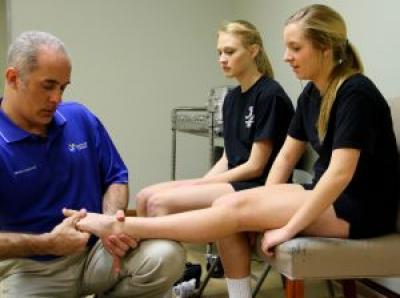Dance is a beautiful form of expression, but it can be physically taxing and strenuous on the human body, particularly for children and adolescents.
According to a new analysis, between 1991 and 2007 the annual number of dance-related injuries increased 37 percent, from 6,175 to 8,477 injuries. Sprains and/or strains were the most common types of dance-related injuries at 52 percent, with falls (45 percent) being the most common causes of injuries.
The paper by researchers at the Center for Injury Research and Policy of The Research Institute at Nationwide Children's Hospital examined dance-related injuries among children and adolescents 3 to 19 years of age from 1991 to 2007. During the 17-year study period, an estimated 113,000 children and adolescents were treated in U.S. emergency departments for dance-related injuries.
They found that 4 out of 10 injured dancers were between 15 and 19 years of age.
"We believe this could be due to adolescent dancers getting more advanced in their skills, becoming more progressed in their careers and spending more time training and practicing," said Kristin Roberts MS, MPH, lead author of the study and senior research associate at the Center for Injury Research and Policy at Nationwide Children's Hospital. "We encourage children to keep dancing and exercising. But it is important that dancers and their instructors take precautions to avoid sustaining injuries."

The Sports Medicine team has created a comprehensive injury prevention program to address the needs of young dancers. Credit: Nationwide Children's Hospital
"Safety precautions such as staying well-hydrated, properly warming up and cooling down, concentrating on the proper technique and getting plenty of rest can help prevent dance-related injuries," said the study's senior author Lara McKenzie, PhD, principal investigator at the Center for Injury Research and Policy at Nationwide Children's and also a faculty member at The Ohio State University College of Medicine.
The Sports Medicine experts at Nationwide Children's treat the types of injuries seen in performing arts and dance athletes. Due to the increase in the number of dance-related injuries seen during the last few years, they have designed a number of services to address the needs of the young dancer.
"Adolescents are still growing into their bodies and as such often develop imbalances that can lead to injury," said Eric Leighton, ATC, an athletic trainer in Sports Medicine at Nationwide Children's. "It's critical that intervention and injury prevention be made available to them to address balance, strength and functional body control deficits as they grow. From pointe readiness screens to injury prevention programming, our team has a comprehensive approach to address the needs of these athletes."
This is the first study to use a nationally representative sample to examine dance-related injuries that were treated in U.S. emergency departments. Data for this study were obtained from the National Electronic Injury Surveillance System (NEISS), which is operated by the U.S. Consumer Product Safety Commission. The NEISS provides information on consumer product-related and sports and recreation-related injuries treated in hospital emergency departments across the country.

An estimated 113,000 children and adolescents were treated in U.S. emergency departments for dance-related injuries. Credit: Nationwide Children's Hospital
Published in the Journal of Physical Activity and Health




Comments